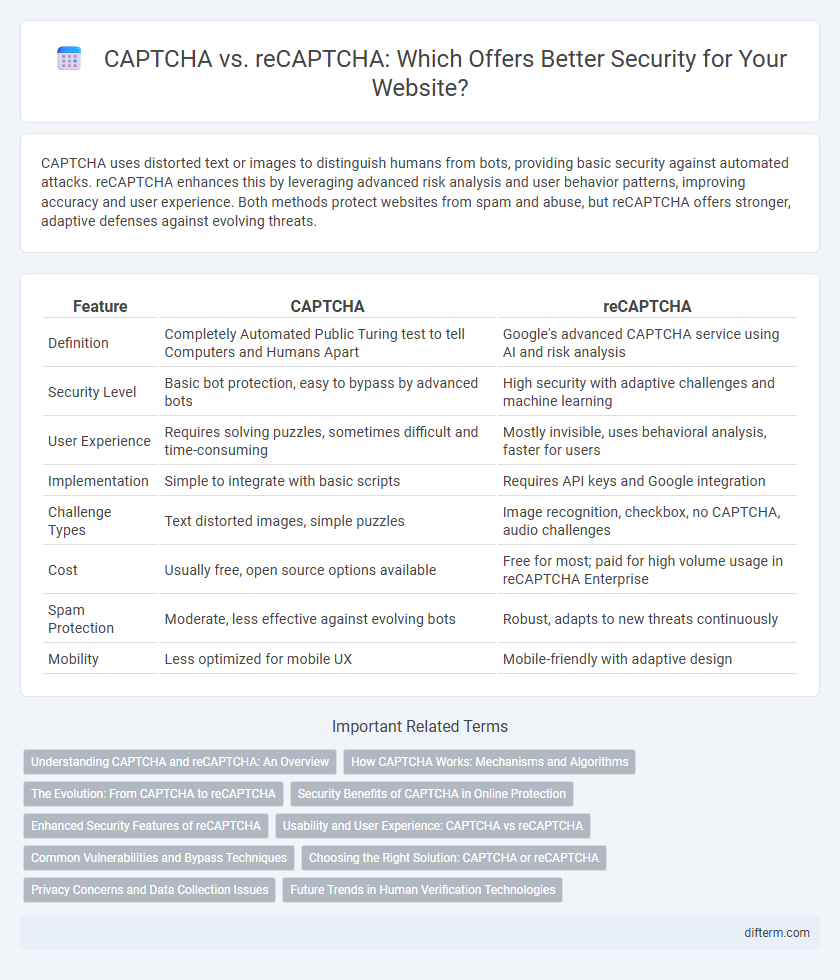CAPTCHA uses distorted text or images to distinguish humans from bots, providing basic security against automated attacks. reCAPTCHA enhances this by leveraging advanced risk analysis and user behavior patterns, improving accuracy and user experience. Both methods protect websites from spam and abuse, but reCAPTCHA offers stronger, adaptive defenses against evolving threats.
Table of Comparison
| Feature | CAPTCHA | reCAPTCHA |
|---|---|---|
| Definition | Completely Automated Public Turing test to tell Computers and Humans Apart | Google's advanced CAPTCHA service using AI and risk analysis |
| Security Level | Basic bot protection, easy to bypass by advanced bots | High security with adaptive challenges and machine learning |
| User Experience | Requires solving puzzles, sometimes difficult and time-consuming | Mostly invisible, uses behavioral analysis, faster for users |
| Implementation | Simple to integrate with basic scripts | Requires API keys and Google integration |
| Challenge Types | Text distorted images, simple puzzles | Image recognition, checkbox, no CAPTCHA, audio challenges |
| Cost | Usually free, open source options available | Free for most; paid for high volume usage in reCAPTCHA Enterprise |
| Spam Protection | Moderate, less effective against evolving bots | Robust, adapts to new threats continuously |
| Mobility | Less optimized for mobile UX | Mobile-friendly with adaptive design |
Understanding CAPTCHA and reCAPTCHA: An Overview
CAPTCHA (Completely Automated Public Turing test to tell Computers and Humans Apart) and reCAPTCHA are security mechanisms designed to differentiate humans from automated bots, enhancing online protection against spam and abuse. While traditional CAPTCHA relies on distorted text or images to verify users, reCAPTCHA leverages advanced risk analysis techniques and machine learning, often incorporating real-world tasks like identifying objects in images to improve security accuracy. Google's reCAPTCHA also contributes to digitizing books and training AI models, making it a multifunctional tool beyond simple bot prevention.
How CAPTCHA Works: Mechanisms and Algorithms
CAPTCHA uses distorted text or image recognition tasks to differentiate humans from bots by challenging automated systems with pattern recognition problems that are difficult for AI to solve. reCAPTCHA enhances security by incorporating risk analysis algorithms and user behavior tracking, allowing it to adapt challenges dynamically and improve bot detection accuracy. Both rely on underlying machine learning models and image processing techniques, but reCAPTCHA leverages Google's vast data resources for continuous algorithm improvement and increased robustness against automated attacks.
The Evolution: From CAPTCHA to reCAPTCHA
CAPTCHA, originally designed to differentiate humans from bots by presenting distorted text images, evolved into reCAPTCHA to improve both security and usability. reCAPTCHA leverages advanced machine learning and user interaction patterns to enhance bot detection accuracy while simultaneously contributing to digital archive digitization. This evolution reflects a shift from simple challenge-response tests to adaptive systems that balance user experience with robust security against automated threats.
Security Benefits of CAPTCHA in Online Protection
CAPTCHA enhances online security by distinguishing between human users and automated bots, preventing unauthorized access and reducing spam attacks. Its visual and interactive challenges protect web forms from brute-force attacks, credential stuffing, and fraudulent activities. Implementing CAPTCHA significantly lowers the risk of data breaches by blocking malicious automated scripts and ensuring genuine user engagement.
Enhanced Security Features of reCAPTCHA
reCAPTCHA incorporates advanced risk analysis techniques, leveraging machine learning to distinguish between human users and bots more accurately than traditional CAPTCHA systems. It offers adaptive challenges that adjust based on user behavior, enhancing security while minimizing user friction. Integration with Google's threat intelligence helps reCAPTCHA detect and block sophisticated automated attacks effectively.
Usability and User Experience: CAPTCHA vs reCAPTCHA
CAPTCHA often relies on distorted text or image recognition tasks that can frustrate users and increase abandonment rates due to its challenging usability. reCAPTCHA enhances user experience by employing advanced risk analysis techniques and minimal user interaction, often verifying users without explicit challenges through invisible or checkbox-based tests. The integration of reCAPTCHA significantly reduces user friction while maintaining security, improving conversion rates and accessibility across diverse user demographics.
Common Vulnerabilities and Bypass Techniques
CAPTCHA systems face common vulnerabilities such as automated solving via OCR, pattern recognition, and machine learning attacks that bypass traditional text-based challenges. reCAPTCHA enhances security by incorporating behavioral analysis and risk scoring, but remains susceptible to advanced bot networks using techniques like human-assisted solving and proxy servers. Continuous improvement in adaptive algorithms and multi-modal CAPTCHAs is critical to counteract emerging bypass methods effectively.
Choosing the Right Solution: CAPTCHA or reCAPTCHA
Selecting the right security solution between CAPTCHA and reCAPTCHA depends on the level of protection and user experience required. CAPTCHA offers basic bot prevention through distorted text and challenges, suitable for low-risk sites, while reCAPTCHA leverages advanced risk analysis and machine learning to detect sophisticated automated attacks. Implementing reCAPTCHA can significantly reduce spam and abuse by utilizing Google's adaptive algorithms and invisible verification, ensuring stronger security with minimal user friction.
Privacy Concerns and Data Collection Issues
CAPTCHA systems primarily aim to distinguish humans from bots, but reCAPTCHA extends this function by integrating with Google's data ecosystem, raising significant privacy concerns due to extensive user data collection and tracking. While traditional CAPTCHA relies on simple challenge-response tests, reCAPTCHA collects behavioral data such as mouse movements, IP addresses, and browsing patterns, potentially exposing sensitive information to third-party entities. This expanded data collection by reCAPTCHA heightens risks related to user profiling and surveillance, challenging compliance with privacy regulations like GDPR.
Future Trends in Human Verification Technologies
Emerging human verification technologies are shifting from traditional CAPTCHA challenges toward advanced reCAPTCHA systems integrated with AI-driven behavioral analysis to enhance security while minimizing user friction. Future trends emphasize adaptive risk assessment by analyzing user interaction patterns and device fingerprints, reducing false positives and improving bot detection accuracy. These innovations aim to balance seamless user experience with robust protection against increasingly sophisticated automated threats.
CAPTCHA vs reCAPTCHA Infographic

 difterm.com
difterm.com